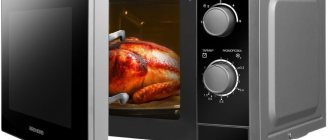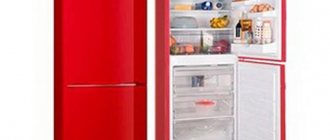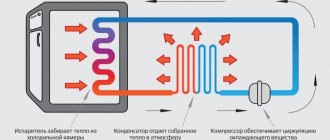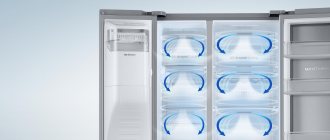The refrigerator is the only household electrical appliance that independently maintains operating condition around the clock. Therefore, you need to know what power the refrigerator has, what energy saving class it belongs to and how much energy it consumes per month. The amount of your monthly electricity bill will largely depend on these indicators.
Energy efficiency classes
Since the early 2000s, the eco-movement has become popular, fighting for the preservation of natural resources and a clean environment. Thanks to this trend, world leaders in the production of household appliances have developed and implemented technologies that save resource consumption. The changes affected large household appliances, such as washing machines, dishwashers, refrigerators, microwave ovens, and vacuum cleaners. In the latest models, the developers have managed to reduce the energy consumption of the refrigerator to a minimum.
In July 2014, the current regulation on the classification of energy efficiency of refrigerators was adopted, and it is uniform for all countries of the world. Each class has its own energy efficiency index, which is calculated using a complex formula and expressed as a percentage of the energy consumption rate.
Refrigerators are divided into the following classes based on the principle of energy consumption:
- A+++ - the most economical option with an index of 10-15%;
- A++ - consumes up to 30%;
- A+ - consumes from 30 to 42%;
- A - eats from 42 to 50%;
- B - from 55 to 75%;
- C - class economy below average, consumption from 75 to 90%;
- D - saves a minimum of energy, consumes from 90 to 100%;
- E - spends more than necessary (from 100 to 110%);
- F is the most energy-consuming class with an index from 110 to 125%.
The most popular are refrigerators that belong to class A and higher.
Equipment with energy consumption classes E and F is practically not produced (this includes all old models).
To determine how much kW a refrigerator consumes per day, just read the equipment passport or find the consumption class designation on a tag or sticker.
What does consumption depend on?
Electricity consumption depends on a number of factors. One of them has already been discussed above - the resource consumption class. Other important indicators affecting power and electricity consumption include:
- volume of refrigerator and freezer;
- dry freezing function;
- compressor power;
- ice maker function;
- presence of a second compressor;
- quality of sealing materials;
- backlight, electronic clock and similar functions;
- maintained temperature inside the chamber.
These are the main factors that affect the energy consumption of a refrigerator. Experts identify several more indirect factors that do not depend on the model and class of equipment. These include:
- frequency of opening the refrigerator;
- temperature in the room: the higher it is, the more often the compressor turns on.
It should be remembered that it is not recommended to place refrigeration equipment next to an oven, stove, microwave and other heating appliances.
What is affected by power consumption?
The average power consumption of a refrigerator affects not only the functionality of the appliance, but also the monthly payment for electricity. Before buying a refrigerator, it is important to study all its capabilities and resource costs so as not to overpay for unnecessary parameters and excessive energy consumption. When choosing a refrigerator, it is important to pay attention to the following criteria:
- How many kg does the camera freeze per day with average energy consumption? If there is more product in the refrigerator than is written in the passport, then the cost of resources for freezing will increase. Conversely, if less space is used regularly, some of the electricity will be wasted.
- The presence of additional functions such as quick freezing, ice maker, dry freezing, etc. Such functions significantly increase the overall energy consumption. If you can do without them, it is better to choose a simpler model.
- Energy efficiency class. It is optimal to choose class A and higher. Average energy consumption is about 35-40 W/hour, and the total savings will increase to 35%.
Find out the power of the refrigerator
To independently measure the power of a modern refrigerator, you can use a multimeter by measuring the readings of the refrigerator circuit with the compressor running. The obtained values must be multiplied by the mains voltage (220V), however, it must be taken into account that when the compressor starts, a current will flow through the circuit that will be two to three times higher than the rated voltage. Therefore, the obtained readings must be multiplied by 3 - if the power is measured for the purpose of connecting a voltage stabilizer, the required stabilizer power must also be added to the multiplier.
The average power of a modern refrigeration unit, as stated in the instructions, is traditionally no more than 250 W, but after measurement it can reach 500 W.
To reduce the energy consumption of your refrigerator, you need to open its door briefly and not too often. Also, the air heated by its rear wall must circulate completely freely, so that the unit switches off less often and consumes less energy. To do this, the refrigerator ventilation grilles must be kept open. Food must be cooled before being placed in the refrigerator, and accumulated ice on the freezer evaporator must be removed at least once a month.
How to calculate consumption
All information about the power and resource costs of the refrigeration unit is indicated in the technical passport. Most often, consumption information is located in the energy saving section and is indicated in kWh/year. Knowing these data, it will not be difficult to calculate how much the refrigerator consumes per month, per day, and even per hour. You just need to perform a few simple mathematical operations.
For example, there is an A++ class refrigerator with a consumption of 220 kWh/year. To find out the monthly resource consumption: 220/12=18.3 kWh. We calculate the daily consumption in the same way: 220/365 = 0.603 kW. You can find out how much the refrigerator consumes per hour in watts: (0.603/24)*1000=25.25 W.
All calculations show average values and may change under the influence of various factors. Also, the calculations do not take into account engineering error.
Comparison with other household appliances
It is believed that large household appliances consume more electricity than small ones. But it is not always the case. Energy consumption depends on the power of the device and its operating time.
If we compare average values, refrigeration equipment with a high energy saving class will be more economical than many other kitchen units. For example, a standard 2 kW electric kettle uses about 28 kWh monthly. A class A refrigerator is about 19 kWh. If you use a computer 3-4 hours a day, then up to 60 kWh will be used up in a month. The consumption of a washing machine will be approximately the same.
How much electricity does a refrigerator consume?
The design of modern household appliances is aimed at maximizing savings in consumed resources. They take into account not only the operating time and power of the equipment, but also the degree of load of the device, energy efficiency class, and the presence of additional functions.
Some brands of refrigeration equipment use a value in liters instead of a letter version of the energy capacity class designation. In this case, the calculation of consumed electrical energy is even simpler: take 1 kW per 1 liter of volume. So, for a refrigerator marked 250 liters, the consumption will be about 250 kW per year.
Lg
New models of LG refrigeration equipment belong to the A++ energy efficiency class, which allows owners to save up to 38% compared to other types of refrigerators. The equipment is equipped with an inverter linear compressor, thanks to which the refrigerator consumes electricity per hour from 25 to 32 W.
Liebherr
Liebherr is a world-famous manufacturer of refrigeration and freezing equipment. The popularity of the products is due to high build quality, ease of use, combination of stylish design and reliability. The big advantage of the latest models is the economical power consumption of the refrigerator, which is less than 1 kW per day.
Biryusa
Biryusa - compact and functional refrigeration units of domestic production. Models available in various sizes and purposes. All units have a 3 year warranty. The latest line of equipment belongs to energy efficiency class A - an average-sized refrigerator consumes about 1000 watts per day.
Indesit
Indesit refrigeration equipment is distinguished by a combination of stylish design, high build quality, and durability. All modern models can save up to 35% of electricity. For an average refrigerator, power consumption ranges from 260 to 330 kW/year.
Atlant
Atlant refrigeration equipment is in demand due to the reliability and versatility of its models. The range includes devices capable of freezing from 6 to 20 kg of food. At the same time, the electricity consumption of a refrigerator of average volume and functionality does not exceed 360-400 kW per year. The exception is models with No Frost technology (energy consumption increases significantly).
All about refrigerator power
The power of the refrigerator directly affects such characteristics as energy consumption, energy efficiency, overall productivity, additional functions and freezing power.
Energy consumption is the nominal amount of electricity that the unit spends on its operation, while energy efficiency is the rational amount of energy consumed by a working refrigerator. The freezing power of a refrigerator is the ability to freeze a certain amount of food per day.
The power of the refrigeration unit itself depends on its external dimensions, the compressor and its power, the power of the fans, the thermal insulation of the seal and the use of additional functions. Various manufacturers produce refrigerators, the freezing capacity of which varies markedly. The class of the unit is usually written on the factory sticker - the letters A, B, C, D, E, G indicate the degree of its energy efficiency. Refrigerators with a sticker A, B or C represent an economical class, with the letter D - an intermediate value, and E and G - high energy consumption of the unit. Today, the market is mainly dominated by A, B and C-class refrigerators.
How to save energy?
The popularity of energy-efficient household appliances is growing every year. Therefore, refrigerator manufacturers are looking for new methods to reduce resource consumption. You cannot force a refrigerator to consume less than what is indicated in the standard table of the technical data sheet. However, losses can be kept to a minimum. Most often, to reduce power consumption they use:
- improvement of the compressor control system;
- ergonomic arrangement of chambers and storage areas of a two-chamber apparatus;
- increasing the reflective properties of the body.
If a two-chamber unit meets all the characteristics described above, but consumes more energy than indicated in the passport, operational errors are possible.
There are a number of tips that will help reduce the amount of energy consumed:
- You should open the refrigerator as little as possible and keep the door open as little as possible. This will help reduce the load on the compressor.
- Cover liquid foods with a lid. The liquid evaporates, so the evaporator works harder, which increases resource costs.
- Do not set minimum temperatures unnecessarily. A lot of energy will be wasted.
- Do not place warm or hot food in the refrigerator compartment.
- It is best to place products evenly throughout the chamber. This will ensure normal air circulation and will not require additional electricity costs.
- Monitor the sealing properties of the seals. Over the years, they wear out, which leads to loss of cold, and this, in turn, causes increased energy consumption.
- Do not place the refrigerator near a stove, oven, radiator or other heating appliance.
- The ventilation hole should not fit tightly against the wall or objects.
- Disconnect the refrigerator from power as little as possible. The peak energy consumption occurs when starting the refrigerator (150-200 W per hour with a starting current of several amperes).
By following these recommendations, you can further save up to 8% in hours of consumption per year from standard electricity consumption.
How to choose an economical model
Which refrigerator is the most economical is determined from the technical documentation; the characteristics of the internal systems of household appliances are also taken into account.
We buy a refrigerator taking into account the following device parameters that affect energy consumption:
- compressor power;
- number of chambers and their volume;
- cooling system characteristics;
- degree of tightness;
- current strength (in amperes);
- characteristics of additional options.
View » Which energy consumption class is better for a refrigerator: energy efficiency table
For modern refrigeration equipment, the presence of a display, super freezing mode, etc. will increase the amount of energy consumption.
Manufacturers produce models with 1-2 compressors. Devices with 2 compressors have more modes, quickly cool food and consume more electricity. Inverter compressors are economical in this regard. These devices quickly reduce the temperature and maintain a stable temperature without large expenditures of electricity; the power is smoothly regulated.
Inverter devices operate without heavy loads on the electrical network and operate almost silently.
Classic refrigerators have a step system and during operation use all the power to lower the temperature and maintain it.
How much the refrigerator consumes is also determined by the cooling system, which can be drip or NoFrost. A drip-type system is more economical; NoFrost technology is more energy-consuming, but ensures comfortable use of household appliances.
For a family of 3-4 people, a two-chamber refrigeration unit is recommended. Models with 1 compartment with a flow rate of 220 kW are used in small spaces. The level of energy consumption depends on the number of chambers and the volume of the refrigerator. A two-chamber unit consumes a little more electricity than a single-chamber unit, while the model with 2 chambers is the most efficient in terms of capacity.
High-quality insulation is airtight and ensures cold retention, reducing energy loss. When the tightness of the equipment is low, energy consumption increases due to the high load on the compressor. Trusted brands produce high-quality equipment with low and medium energy consumption.
Energy consumption can be minimized through improvements to the engine management system, ergonomic chambers and storage areas. This indicator is also reduced by the increased reflective properties of the device body.
It is recommended to open the refrigerator less often to minimize energy consumption. Do not place warm foods or hot dishes in the freezer. The products are distributed evenly in the refrigerator for stable air circulation.
It is recommended to check the tightness of the seals. The material wears out during operation, which leads to loss of tightness of the structure. Do not install the refrigeration unit next to an electric stove, oven, radiator or other heating appliances. It is recommended that you disconnect the equipment from the power supply less frequently. By taking these recommendations into account, you can save up to 8% of the total amount of electricity.











